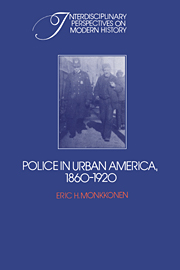Summary
Never hit a prisoner over the head with your pistol, because you may afterwards want to use your weapon and find it inoperable.
David J. Cook, Hands Up (1882)The police in the context of urban history
For us to comprehend the blundering, ignorance, inefficiency, incompetence, and general confusion of the nineteenth-century police when dealing with crime requires an imaginative leap over a great distance. In an age when the best forensic techniques could not clearly distinguish the blood of a pig from the blood of a human, the art of criminal detection bore more than a little resemblance to divination. In such a world, we should not wonder that people afraid of crime and criminals hoped that the appearance of a man in a uniform would strike the hearts of potential criminals with fear, just as in late nineteenth-century novels the appearance of a cross caused vampires to cringe and shrink back. Unfortunately, neither technique worked especially well, and as a result the police spent the most useful of their long hours on duty reporting open sewers, shooting stray dogs, and arresting drunks. If the appearance of a uniform deterred any potential criminals, their nonbehavior left little or no mark in the historical record.
As the United States industrialized in the nineteenth century, Americans experienced physical uncertainty and insecurity we would find intolerable today. Steamboats blew up. People drowned in shallow water, unable to swim. Trains regularly mutilated and killed pedestrians. Children got run over by wagons.
- Type
- Chapter
- Information
- Police in Urban America, 1860–1920 , pp. 1 - 29Publisher: Cambridge University PressPrint publication year: 1981



